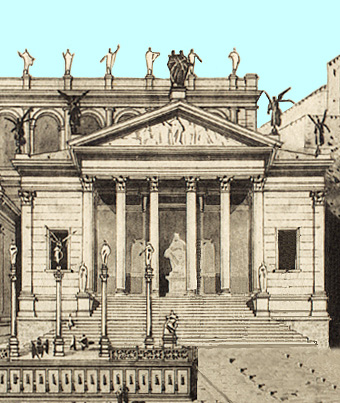
From the foot of a long and imposing flight of stairs, you gaze up at the Temple of Concordia Augusta, dedicated to "the harmony of the Augustan family" by Tiberius, then heir apparent of the Emperor Augustus, in 10 CE. Inside the cella, a vast hall placed crosswise behind the temple porch, you glimpse the statue of the goddess Concordia, whom Augustus and later emperors appropriated as Concordia Augusta to symbolize both the peace and stability they had brought to the empire and the harmony within the imperial family. You reflect on the possible irony of the name of this temple, as you remember the long and sometimes tragic wrangles over succession within the Julio-Claudian family.
This temple (see sestertius of Tiberius and reconstruction view from the side, courtesy of UCLA's Digital Roman Forum) replaced an earlier Temple of Concord, which had been destroyed in a fire in 9 BCE. The name of this earlier temple had its own irony, since it had been built by the consul Lucius Opimius in 121 BCE to celebrate the victory of the optimates, the aristocratic faction of senators, over the reforms sought by the populares, led by the tribunes Tiberius and Gaius Gracchus.